Is anyone working on their own SCINI yet?
Who has signed up for SCUBA lessons so you can come down to Antarctica to be a scientist or to help the scientists?
On Thursday we had another meeting at Moss Landing Marine Labs and learned more about the details of the actual work involved in deploying SCINI and in keeping the SCUBA divers safe in the water in Antarctica.
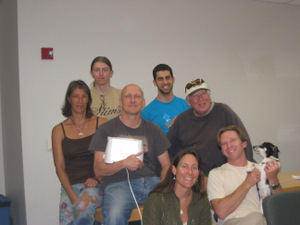 Stacy, David, Paul, Bob, John, Tina, and Kevin. (No the toaster and Pookie the doggie are not coming with us).
Stacy, David, Paul, Bob, John, Tina, and Kevin. (No the toaster and Pookie the doggie are not coming with us).
To get SCINI in the water involves a great deal of setup. First we’ll have to pack all of our stuff each day. Then we’ll get in some kind of a vehicle like a Mattruck, Skidoo, Spryte, or Piston Bully. After a couple hours of driving through amazing landscape to get to our chosen spot on the ice we’ll have to drill at least two 1 to 7 meter holes: a 20 cm hole for SCINI to enter the ice through and a 12 cm navigation hole. Then we’ll have to set up the control room for SCINI, which involves connecting lots of computers and cables either in a tent or in the back of a vehicle. At the same time some of our ICE AGED team will be setting up the navigation which involves aligning parts of our GPS system and the engineers will be taking SCINI out of her box and getting her ready. Then we’ll launch her into the water and for the next few hours, the pilots will navigate her and use her to take pictures for us, record movies, and even grab organisms or things if we need her to.
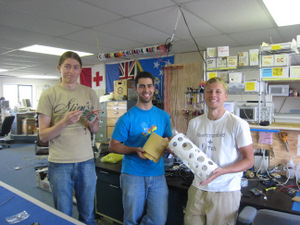 ICE AGED Engineers and SCINI parts. David with his chips, Paul with some flotation, and Justin with housing
ICE AGED Engineers and SCINI parts. David with his chips, Paul with some flotation, and Justin with housing
A few things which we’ll have to be careful with include not forgetting anything either at McMurdo or at our field site as it’s a long drive back. We also have to be careful of not accidentally losing anything down a hole. That would be hard to get back. We also have to be careful to not let the drill get stuck and frozen in the ice which apparently happens as we get closer to the water under the ice. Lastly, we’ll have to completely dry all the equipment at the end of the day as any remaining drop could freeze and destroy some of the electronics when we take her back out on the ice. We hope nothing goes wrong with SCINI and that our talented engineers will be able to fix her if anything does come up.
Some days SCINI will be at one site and the SCUBA divers will be at another site. Many days SCINI will go out first and once she’s done the SCUBA divers will go down to the same area. To get the SCUBA divers in the water is much less work. Yes, we have to make the hole bigger, but we won’t need all the extra equipment. We will have to help the divers get all of their gear, such as dry suits, 2-3 hoods, and dry gloves, on. We’ll also help them with their equipment, things such as a weight harness (not a weight belt), two separate regulators, and heavy tanks.
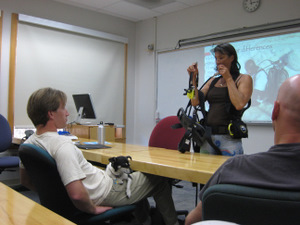 Stacy showing Kevin and Bob how to set up their regulators. 2 hoses need to be on the left side!
Stacy showing Kevin and Bob how to set up their regulators. 2 hoses need to be on the left side!
Then our divers will disappear down the ice hole and enter the amazing world under the ice. They will be taking pictures and doing video transects of worms, clams, and crustaceans and whatever else they see at the bottom of the ocean. They’ll also be taking core samples which involves scooping out a cylinder of mud and silt from the bottom of the ocean and bringing it back to the surface and then the labs so we can analyze what’s living in it. Lastly they’ll be counting clams! They won’t have more than 30- 45 minutes to do all of this before they have to come back up to the surface.
At our meeting we talked about some of the things that the divers have to be careful with. What do you think that would be? 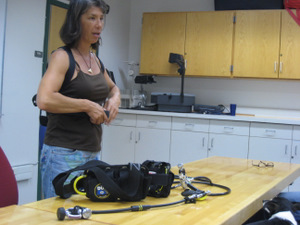 Stacy and some of the SCUBA gear
Stacy and some of the SCUBA gear
A couple points stuck out to me which included the reminder for the divers that if they get in trouble under the ice they should not go up. Can you think of why?
Useful signs of hypothermia include a fun assortment of words including grumble and stumble and the divers have to be careful as they will be colder after the dive when they are relaxing back on the surface. Why would that be?
Lastly, I found it interesting that the divers will have great visibility but, because of the thick ice overhead, it’ll be so dark that they will need good lights.
So what do you think now? Are you ready to SCUBA dive in Antarctica or are you going to go build an underwater robot that’s even cooler than SCINI?
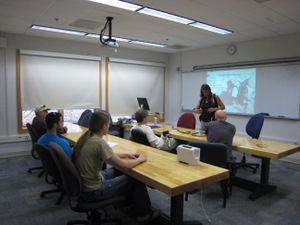 John, Paul, David, Kevin, and Bob watch as Stacy models some of the SCUBA equipment.
John, Paul, David, Kevin, and Bob watch as Stacy models some of the SCUBA equipment.

